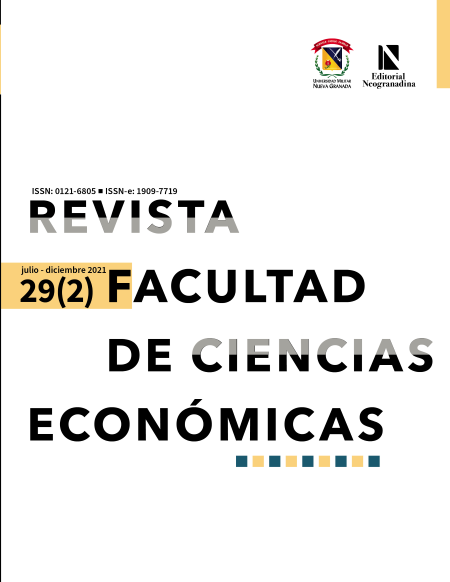Relación entre controles formales e informales, identificación organizacional y desempeño de los gerentes de empresas familiares
Resumen
El estudio tuvo el propósito de analizar la relación entre controles formales e informales, identificación organizacional y desempeño gerencial en empresas familiares brasileñas. Para recolectar los datos, se aplicó un cuestionario a los gestores de empresas familiares, con la obtención de 98 respuestas. La investigación se caracteriza como cuantitativa, y el método empleado para analizar los datos fue el Modelo de Ecuaciones Estructurales y el Fuzzy set Qualitative Comparative Analisys (FSQCA). Los resultados revelan que los controles informales (cultural y de personal) influyen positiva y significativamente el desempeño gerencial, al tiempo que los controles formales y la identificación organizacional no influyen en el desempeño gerencial. Sin embargo, en el enfoque asimétrico, los resultados también señalaron que el control de personal es una solución central en la predicción de alto desempeño gerencial. Los controles de acción y resultado también se mostraron importantes, aunque sean relativamente poco utilizados en empresas familiares. Estos hallazgos sugieren configuraciones distintas e igualmente efectivas que predigan alto desempeño gerencial, por lo tanto, los gestores necesitan dedicar atención a las diferentes formas de control y sus impactos en el nivel de identificación organizacional. El estudio aporta al conocimiento del área al mostrar que la identificación organizacional no presenta impacto significativo en la relación entre controles y desempeño gerencial en empresas familiares, lo que fue sorprendente y amerita nuevas investigaciones.
Descargas
Referencias bibliográficas
Abernethy, M. A. e Brownell, P. (1997). Management control systems in research and development organizations: The role of accounting, behavior and personnel controls. Accounting, Organizations and Society, 22(3-4), 233-248. https://doi.org/10.1016/S0361-3682(96)00038-4
Abernethy, M. A. e Chua, W. F. (1996). A field study of control system “redesign”: The impact of institutional processes on strategic choice. Contemporary Accounting Research, 13(2), 569-606. https://doi.org/10.1111/j.1911-3846.1996.tb00515.x
Adler, P. S. e Borys, B. (1996). Two types of bureaucracy: Enabling and coercive. Administrative science quarterly, 61-89. https://doi.org/10.2307/2393986
Almeida, D., Beuren, I. e Monteiro, J. (2021). Reflexes of organizational values on the reward system in a family business. Brazilian Business Review, 18(2), 140-159. https://doi.org/10.15728/bbr.2021.18.2.2
Anthony, R. N. (1965). Planning and control systems: A Framework for analysis. Division of Research, Graduate School of Business Administration, Harvard University.
Ashforth, B. E. e Mael, F. (1989). Social identity theory and the organization. Academy of management review, 14(1), 20-39. https://doi.org/10.5465/amr.1989.4278999
Ballinger, G. A. e Marcel, J. J. (2010). The use of an interim ceo during succession episodes and firm performance. Strategic Management Journal, 31(3), 262-283. https://doi.org/10.1002/smj.808
Bennedsen, M., Fan, J. P., Jian, M. e Yeh, Y. H. (2015). The family business map: Framework, selective survey, and evidence from Chinese family firm succession. Journal of Corporate Finance, 33, 212-226. https://doi.org/10.1016/j.jcorpfin.2015.01.008
Bhattacharya, C. B., Rao, H. e Glynn, M. A. (1995). Understanding the bond of identification: An investigation of its correlates among art museum members. Journal of marketing, 59(4), 46-57. https://doi.org/10.1177/002224299505900404
Cantisano, G. T. e Domínguez, J. F. M. (2007). Identificación organizacional y ruptura de contrato psicológico: sus influencias sobre la satisfacción de los empleados. International Journal of Psychology and Psychological Therapy, 7(3), 365-379. https://www.redalyc.org/articulo.oa?id=56070305
Carmeli, A., Gilat, G. e Waldman, D. A. (2007). The role of perceived organizational performance in organizational identification, adjustment and job performance. Journal of Management Studies, 44(6), 972-992. https://doi.org/10.1111/j.1467-6486.2007.00691.x
Carmon, A. F., Miller, A. N., Raile, A. N. e Roers, M. M. (2010). Fusing family and firm: Employee perceptions of perceived homophily, organizational justice, organizational identification, and organizational commitment in family businesses. Journal of Family Business Strategy, 1(4), 210-223. https://doi.org/10.1016/j.jfbs.2010.10.003
Cheney, G. (1982). Identification as process and product: A field study (dissertação de mestrado não publicada, Purdue University).
Chenhall, R. H. (2003). Management control systems design within its organizational context: Findings from contingency-based research and directions for the future. Accounting, organizations and society, 28(2-3), 127-168. https://doi.org/10.1016/S0361-3682(01)00027-7
Chenhall, R. H. e Moers, F. (2015). The role of innovation in the evolution of management accounting and its integration into management control. Accounting, Organizations and Society, 47, 1-13. https://doi.org/10.1016/j.aos.2015.10.002
Chenhall, R. H., Hall, M. e Smith, D. (2010). Social capital and management control systems: A study of a non-government organization. Accounting, organizations and Society, 35(8), 737-756. https://doi.org/10.1016/j.aos.2010.09.006
Chrisman, J. J., Sharma, P. e Taggar, S. (2007). Family influences on firms: An introduction. Journal of Business Research, 60(10), 1005-1011. https://doi.org/10.1016/j.jbusres.2007.02.016
Cohen, J. (1988). Statistical power analysis for the behavioral sciences: Jacob Cohen. J Am Stat Assoc, 84(363), 19-74.
Cromie, S., Stephenson, B. e Monteith, D. (1995). The management of family firms: An empirical investigation. International Small Business Journal, 13(4), 11-34. https://doi.org/10.1177/0266242695134001
Cucculelli, M. e Bettinelli, C. (2016). Corporate governance in family firms, learning and reaction to recession: Evidence from Italy. Futures, 75, 92-103. https://doi.org/10.1016/j.futures.2015.10.011
Davila, T. (2005). An exploratory study on the emergence of management control systems: Formalizing human resources in small growing firms. Accounting, Organizations and Society, 30(3), 223-248. https://doi.org/10.1016/j.aos.2004.05.006
Duréndez, A., Madrid-Guijarro, A. e García-Pérez-de-Lema, D. (2011). Innovative culture, management control systems and performance in small and medium-sized Spanish family firms. Innovar, 21(40), 137-154. http://www.scielo.org.co/scielo.php?script=sci_arttext&pid=S0121-50512011000200011
Dutton, J. E., Dukerich, J. M. e Harquail, C. V. (1994). Organizational images and member identification. Administrative science quarterly, 239-263. https://doi.org/10.2307/2393235
Dyer, W. G. (1989). Integrating professional management into a family owned business. Family business review, 2(3), 221-235. https://doi.org/10.1111/j.1741-6248.1989.00221.x
Eisenhardt, K. M. (1985). Control: Organizational and economic approaches. Management science, 31(2), 134-149. https://doi.org/10.1287/mnsc.31.2.134
Epitropaki, O. e Martin, R. (2005). The moderating role of individual differences in the relation between transformational/transactional leadership perceptions and organizational identification. The Leadership Quarterly, 16(4), 569-589. https://doi.org/10.1016/j.leaqua.2005.06.005
Fávero, L. P. e Belfiore, P. (2014). Métodos quantitativos com Stata: Procedimentos, rotinas e análise de resultados (v. 1). Elsevier Brasil.
Fiss, P. C. (2011). Building better causal theories: A fuzzy set approach to typologies in organization research. Academy of Management Journal, 54(2), 393-420. https://doi.org/10.5465/amj.2011.60263120
Goebel, S. e Weißenberger, B. E. (2017). The relationship between informal controls, ethical work climates, and organizational performance. Journal of Business Ethics, 141(3), 505-528. https://doi.org/10.1007/s10551-015-2700-7
Gok, S., Karatuna, I. e Karaca, P. O. (2015). The role of perceived supervisor support and organizational identification in job satisfaction. Procedia-Social and Behavioral Sciences, 177, 38-42. https://doi.org/10.1016/j.sbspro.2015.02.328
Hair Jr, J. F., Hult, G. T. M., Ringle, C. e Sarstedt, M. (2016). A primer on partial least squares structural equation modeling (pls-sem). Sage publications.
Hair, J. F., Risher, J. J., Sarstedt, M. e Ringle, C. M. (2019). When to use and how to report the results of pls-sem. European business review, 31(1),2-24. https://doi.org/10.1108/EBR-11-2018-0203
Haslam, S. A. (2001). The social identity approach. Psychology in organisations.
Heinicke, A., Guenther, T. W. e Widener, S. K. (2016). An examination of the relationship between the extent of a flexible culture and the levers of control system: The key role of beliefs control. Management Accounting Research, 33, 25-41. https://doi.org/10.1016/j.mar.2016.03.005
Kaplan, R. S. e Johnson, H. T. (1987). Relevance lost: The rise and fall of management accounting. Harvard Business School Press.
Kaplan, R. S. e Norton, D. P. (1996). Linking the balanced scorecard to strategy. California Management Review, 39(1), 53-79.
Kaya, B., Abubakar, A. M., Behravesh, E., Yildiz, H. e Mert, I. S. (2020). Antecedents of innovative performance: Findings from pls-sem and Fuzzy sets (fsqca). Journal of Business Research, 114, 278-289. https://doi.org/10.1016/j.jbusres.2020.04.016
Kreiner, G. E. e Ashforth, B. E. (2004). Evidence toward an expanded model of organizational identification. Journal of Organizational Behavior: The International Journal of Industrial, Occupational and Organizational Psychology and Behavior, 25(1), 1-27. https://doi.org/10.1002/job.234
Lange, D., Boivie, S. e Westphal, J. D. (2015). Predicting organizational identification at the ceo level. Strategic Management Journal, 36(8), 1224-1244. https://doi.org/10.1002/smj.2283
Langfield-Smith, K. (1997). Management control systems and strategy: A critical review. Accounting, organizations and society, 22(2), 207-232. https://doi.org/10.1016/S0361-3682(95)00040-2
Lansberg, I. (1999). Succeeding generations: Realizing the dream of families in business. Harvard Business Review Press.
Lima Duarte, F. C., Girão, L. F. D. A. P. e Paulo, E. (2017). Avaliando modelos lineares de value relevance: eles captam o que deveriam captar?. Revista de Administração Contemporânea, 21(spe), 110-134. https://doi.org/10.1590/1982-7849rac2017160202
López, O. L. e Hiebl, M. R. (2015). Management accounting in small and medium-sized enterprises: Current knowledge and avenues for further research. Journal of Management Accounting Research, 27(1), 81-119. https://doi.org/10.2308/jmar-50915
Lunkes, R. J., Rosa, F. S. D., Monteiro, J. J. e Bortoluzzi, D. A. (2020). Interactions among environmental training, environmental strategic planning and personnel controls in radical environmental innovation. Sustainability, 12(20), 8748. https://doi.org/10.3390/su12208748
Mael, F. A. e Ashforth, B. E. (1995). Loyal from day one: Biodata, organizational identification, and turnover among newcomers. Personnel Psychology, 48(2), 309-333. https://doi.org/10.1111/j.1744-6570.1995.tb01759.x
Mael, F. e Ashforth, B. E. (1992). Alumni and their alma mater: A partial test of the reformulated model of organizational identification. Journal of organizational Behavior, 13(2), 103-123. https://doi.org/10.1002/job.4030130202
Malmi, T. e Brown, D. A. (2008). Management control systems as a package: Opportunities, challenges and research directions. Management accounting research, 19(4), 287-300. https://doi.org/10.1016/j.mar.2008.09.003
Matherne, C., Waterwall, B., Ring, J. K. e Credo, K. (2017). Beyond organizational identification: The legitimization and robustness of family identification in the family firm. Journal of family business strategy, 8(3), 170-184. https://doi.org/10.1016/j.jfbs.2017.08.001
Merchant, K. A. (1985). Control in business organization. Financial Times/Prentice Hall.
Merchant, K. A. e Van Der Stede, W. A. (2007). Management control systems: Performance measurement, evaluation and incentives. Pearson Education.
Miller, D. (1993). Some organizational consequences of ceo succession. Academy of Management Journal, 36(3), 644-659. https://doi.org/10.5465/256597
Miller, D., Le Breton-Miller, I., Lester, R. H. e Cannella Jr, A. A. (2007). Are family firms really superior performers?. Journal of Corporate Finance, 13(5), 829-858. https://doi.org/10.1016/j.jcorpfin.2007.03.004
Muñoz, P. e Kibler, E. (2016). Institutional complexity and social entrepreneurship: A fuzzy-set approach. Journal of Business Research, 69(4), 1314-1318. https://doi.org/10.1016/j.jbusres.2020.04.016
Otley, D. (2001). Extending the boundaries of management accounting research: Developing systems for performance management. The British Accounting Review, 33(3), 243-261. https://doi.org/10.1006/bare.2001.0168.
Otley, D., Broadbent, J. e Berry, A. (1995). Research in management control: An overview of its development. British Journal of management, 6, S31-S44. https://doi.org/10.1111/j.1467-8551.1995.tb00136.x
Ouchi, W. G. (1979). A conceptual framework for the design of organizational control mechanisms. Management science, 25(9), 833-848.
Prencipe, A., Bar-Yosef, S. e Dekker, H. C. (2014). Accounting research in family firms: Theoretical and empirical challenges. European Accounting Review, 23(3), 361-385. https://doi.org/10.1080/09638180.2014.895621
Santos, V., Beuren, I. M., Bernd, D. C. e Kaveski, I. D. S. (2018, 25-27 julho). Efeitos do sistema de controle gerencial no desempenho individual mediado pela aprendizagem organizacional. Em XVIII usp Internacional Conference in Accounting. Universidade de São Paulo. https://congressousp.fipecafi.org/anais/18UspInternational/ArtigosDownload/1036.pdf
Ragin, C. C. (2009). Qualitative comparative analysis using fuzzy sets (fsqca). Configurational comparative methods: Qualitative comparative analysis (qca) and related techniques, 51, 87-121. https://dx.doi.org/10.4135/9781452226569.n5
Shanker, M. C. e Astrachan, J. H. (1996). Myths and realities: Family businesses’ contribution to the us economy: A framework for assessing family business statistics. Family Business Review, 9(2), 107-123. https://doi.org/10.1111/j.1741-6248.1996.00107.x
Shields, M. D., Deng, F. J. e Kato, Y. (2000). The design and effects of control systems: Tests of direct-and indirect-effects models. Accounting, Organizations and Society, 25(2), 185-202. https://doi.org/10.1016/S0361-3682(99)00041-0
Simons, R. (1995) Levers of control: How managers use innovative control systems to drive strategic renewal. Harvard Business Press.
Songini, L., Morelli, C. e Vola, P. (2018). Managerial control systems in family business: State of the art. Performance Measurement and Management Control: The Relevance of Performance Measurement and Management Control Research, 193. https://doi.org/10.1108/S1479-351220180000033008
Spekle, R. F. e Verbeeten, F. H. (2014). The use of performance measurement systems in the public sector: Effects on performance. Management Accounting Research, 25(2), 131-146. https://doi.org/10.1016/j.mar.2013.07.004
Tavares, S. M., van Knippenberg, D. e van Dick, R. (2016). Organizational identification and “currencies of exchange”: Integrating social identity and social exchange perspectives. Journal of Applied Social Psychology, 46(1), 34-45. https://doi.org/10.1111/jasp.12329
Van de Ven, A. H. e Ferry, D. L. (1980). Measuring and assessing organizations. John Wiley & Sons.
Van der Kolk, B., van Veen-Dirks, P. M. e ter Bogt, H. J. (2019). The impact of management control on employee motivation and performance in the public Sector. European Accounting Review, 28(5), 901-928. https://doi.org/10.1080/09638180.2018.1553728
Van Knippenberg, D., Van Dick, R. e Tavares, S. (2007). Social identity and social exchange: Identification, support, and withdrawal from the job. Journal of Applied Social Psychology, 37(3), 457-477. https://doi.org/10.1111/j.1559-1816.2007.00168.x
Van Knippenberg, D. e Sleebos, E. (2006). Organizational identification versus organizational commitment: Self‐definition, social exchange, and job attitudes. Journal of Organizational Behavior: The International Journal of Industrial, Occupational and Organizational Psychology and Behavior, 27(5), 571-584. https://doi.org/10.1002/job.359
Van Knippenberg, D. (2000). Work motivation and performance: A social identity perspective. Applied Psychology, 49(3), 357-371. https://doi.org/10.1111/1464-0597.00020
Vandenbosch, B. (1999). An empirical analysis of the association between the use of executive support systems and perceived organizational competitiveness. Accounting, Organizations and Society, 24(1), 77-92. https://doi.org/10.1016/S0361-3682(97)00064-0
Wang, H. J., Demerouti, E. e Le Blanc, P. (2017). Transformational leadership, adaptability, and job crafting: The moderating role of organizational identification. Journal of Vocational Behavior, 100, 185-195. https://doi.org/10.1016/j.jvb.2017.03.009
Widener, S. K. (2007). An empirical analysis of the levers of control framework. Accounting, Organizations and Society, 32(7-8), 757-788. https://doi.org/10.1016/j.aos.2007.01.001
Zhang, Y. e Chen, C. C. (2013). Developmental leadership and organizational citizenship behavior: Mediating effects of self-determination, supervisor identification, and organizational identification. The Leadership Quarterly, 24(4), 534-543. https://doi.org/10.1016/j.leaqua.2013.03.007












